The latest events ...
You can find some of the latest events around the club here.
Third summer party of the local club R01 Düsseldorf
Our third summer party of the local club R01 took place on August 3, 2025, in the beautiful surroundings of the lake Unterbacher See in Düsseldorf.
In sunny weather, more than 30 OMs/YLs from the Düsseldorf area and surrounding region gathered at the lake, including guests from other local clubs. In a relaxed atmosphere with drinks and barbecue, those present exchanged ideas about our shared hobby. Of course, we were also QRV on the bands and were able to reach many stations in Europe with a Japanese FT-DX10 shortwave transceiver, which was powered by an electric car battery!
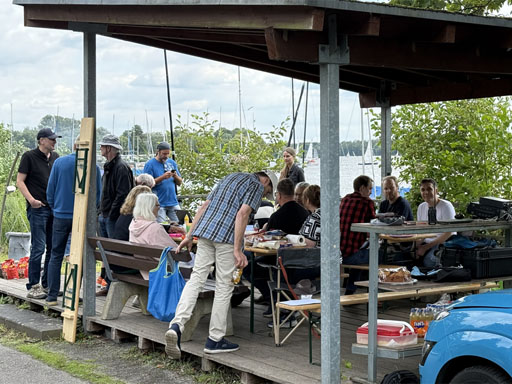
Relaxed atmosphere at the summer party. (Photo: Andreas, DC4AB)
The summer party was a good alternative to a field day, the atmosphere was excellent, and we plan to repeat it in the summer of 2026.
Antenna dismantling for a deceased member
At the beginning of 2024, a long-standing member of our local club passed away unexpectedly. The family asked us for help to dismantle the antenna system on the deceased's house.
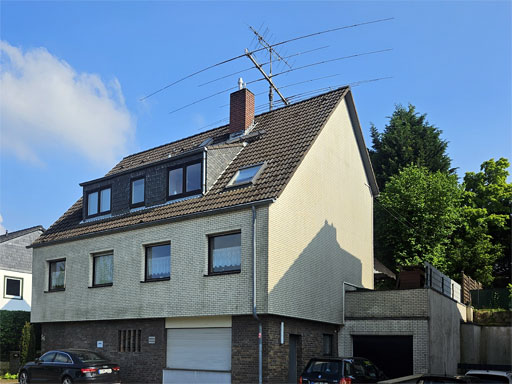
The antenna system during an inspection one week before dismantling. (Photo: Thomas, DK8YJ)
On the day of dismantling, the weather, which had been forecast as unsettled, helped and it remained pleasant and dry. While Michael (DL5JS) and Andreas (DC4AB) secured themselves on the roof to dismantle the heavy antennas into their individual parts, Anton (DE5RAK) and Hendrik (DM5MD) took delivery of the dismantled parts in the garden.
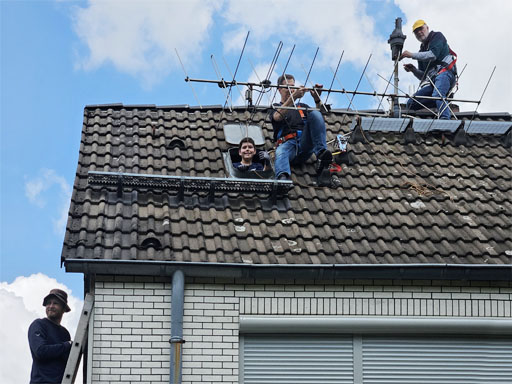
On the roof, Hendrik (DM5MD), Anton (DE5RAK), Andreas (DC4AB) and Michael (DL5JS)
dismantle the antennas from the mast. (Photo: Thomas, DK8YJ)
Meanwhile, Klaus (DL5RFK) and Thomas (DK8YJ) took care of pulling back the antenna cables laid along the house and dismantling the radio station.
After only six and a half hours, the mast on the roof was freed from its antennas and the antenna parts were stowed away in our cars for disposal.
Summer party and field day of R01
The first summer party of the local club R01 took place on August 20, 2023, in the beautiful surroundings of lake Unterbach See in Düsseldorf.
In summer temperatures, many of our active members met at the lake and exchanged ideas about our shared hobby in a relaxed atmosphere over drinks and barbecue. Of course, we were also QRV on the bands and used the DARC vehicle of our North Rhine district as a radio station. Our FT-920 transceiver was powered by an electric car battery! At the same time, we transmitted QRP with an IC-705 on a magnetic loop antenna.
A particularly interesting topic of conversation was the role of amateur radio in the context of local emergency plans of aid organizations such as the THW or the Maltese Aid Service. We want to pursue this topic further and discuss it with these organizations to understand whether, how, and in what role our local club could be involved.
The summer party was a good addition to a field day, the atmosphere was excellent, and we plan to repeat it in the summer of 2024.
Re-assembly of the shortwave dipole antennas
Almost two years after we had to dismantle our three dipole antennas for the shortwave bands 40 meters, 80 meters and 160 meters, we were able to mount these antennas on a new mounting point on Saturday, April 29, 2023. The antennas had to be dismantled because the old neighboring school building of the Franz-Jürgens-Berufskolleg had to be demolished after many years. The antennas had been mounted for several years between the main building (C-building) of the Heinrich-Hertz-Berufskolleg (where our club station is located) and the building of the Franz-Jürgens-Berufskolleg, which was demolished in 2021.
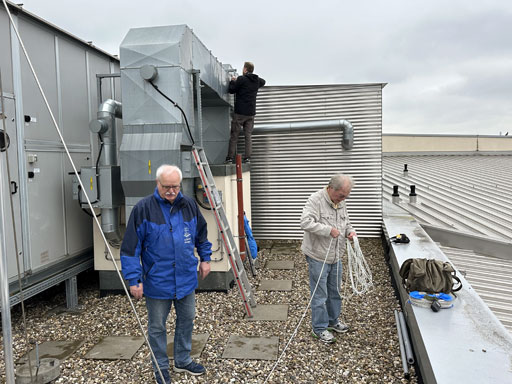
Hendrik (DM5MD) mounts the eyebolts in the background, Hans-Georg (DL6WA) and
Holger (DL5KUT) prepare the auxiliary rope to raise the antennas. (Photo: Andreas, DC4AB)
We are very lucky that the education authority of the city of Düsseldorf allows us to mount the antennas now to the extension building (E-building) of the Heinrich-Hertz-Berufskolleg, which was built at the end of 2018. Fortunately, suitable mounting holes were already found on the steel framework of the ventilation system, into which we were able to mount stainless eyebolts, as used in shipbuilding. The antenna ropes could be tied to these screws.

Klaus (DL5RFK) and Michael (DL5JS) fix the tight rope of the 20-meter antenna,
Manfred (DH9EO) traces the antenna cable. (Photo: Andreas, DC4AB)
The setup of the three antennas started at 10 am and was done in less than five hours. Hans-Georg (DL6WA), Michael (DL5JS), Marc (DM1MF), Holger (DL5KUT), Klaus (DL5RFK), Anton, Andreas (DC4AB), Manfred (DH9EO), Hendrik (DM5MD) and Norbert (DD1NK) helped. Appropriate for the work, the weather was shady and heavily overcast, but dry throughout. The span of the antennas between the buildings is between 100 meters and 86 meters, the center fed antennas hang about 30 meters above the school yard.

The ropes of the antennas for the 160-meter band and the 80-meter band
from the new E-building to the main building. (Photo: Hendrik, DM5MD)
After hanging and connecting the antennas, they were measured. It turned out that something was wrong with the middle of the three antennas. The measurement showed a very poor standing wave ratio, so the electrical length of the antenna for the 80-meter band did not match the intended frequency of 3.5 MHz. Fortunately, the antenna could be quickly retracted to one of the buildings and the centered feed point replaced by a new part. After that, the antenna was pulled back between the buildings and the rope ends were tied well again. After that the standing wave ratio was correct. Now all three shortwave dipole antennas are ready for use again.
Lecture on digital antenna rotors
During the local chapter evening in March 2023, Klaus (DL5RFK) gave a talk on digital antenna rotors. He talked about the motivation to digitize the rotors on our club station. For example, there is a desire to be able to control all rotors on the club station from all radio seats. So far, this is only possible at the table where the respective control unit is located. The control should still be possible at a box via hardware buttons, but in the future it should also work via software on the PC, for example directly from the logging software Wintest. This works, for example, with GS-232 commands, as suggested by Yeasu.
The project for this had already been started last year together with some members of the local chapter after the rotor for the 10-meter Yagi antenna had been disassembled and repaired in May 2022. An already existing hardware of RemoteQTH served as starting point for the control, this is based on an Ardiuno chip. In the beginning the firmware of YO3RAK was used, then an extended version of ON7EQ was tried. In the meantime, an own DL0DX fork of the software was created on Github and already own adjustments and extensions were made.

Klaus (DL5RFK) gave a talk at the local chapter evening. (Photo: Andreas, DC4AB)
During the twenty minute talk Klaus showed some photos of the self-developed test boards and summarized the state of progress for the attendees.
Annual general meeting with election of the board
For the first local chapter evening of 2023, our annual general meeting took place on 19 January. The statutory election of the board had to be cancelled in 2021. Therefore, a regular election of the new board took place this year. There were 20 members and guests present at the meeting, 16 of whom were entitled to vote.
The local association chairman Andreas (DC4AB) was confirmed in his position. A change was made in the position of Vice-Chairman. After six years in the position, Robert (DO7II) did not stand for re-election. Hendrik (DM5MD) was elected as his successor.
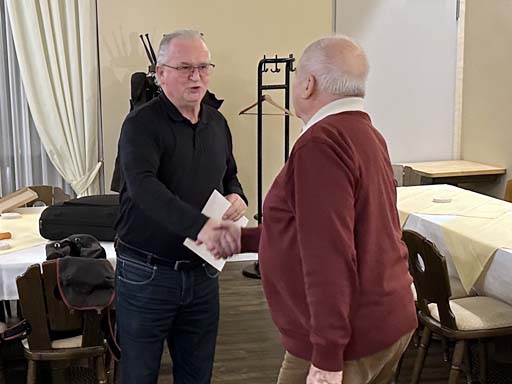
The district chairman Peter (DL1EIP) (left)
honoured Dieter (DL2GK) for 60 years of membership in the DARC. (Photo: Andreas, DC4AB)
The district chairman Peter (DL1EIP) visited the annual general meeting. He used the opportunity to personally honour some long-standing DARC members and present them with certificates and pins.
Kale meal 2022
After the traditional kale meal had to be cancelled for two years due to the Corona pandemic, it could take place again on 1 December 2022. So 24 members, friends and guests met to enjoy the deliciously prepared kale with smoked sausage, smoked pork loin and meatball in the usual cosy atmosphere and to have a lively chat.

Delicious kale in convivial company. (Photo: Andreas, DC4AB)
Repair of the rotor for the 10 meter Yagi antenna
The rotor at the base of the Yagi antenna for the 10-meter band no longer worked reliably, the control unit could no longer detect the current direction of the antenna. Therefore the rotor, a Daiwa MR-750, was dismantled and disassembled together on May 1, 2022. It quickly became clear that a connecting cable on the potentiometer for direction detection had come loose. Inside the rotor had also accumulated a lot of white powder. Presumably, this was aluminum oxide, which had formed in recent years due to corrosion.
In the morning of Mai 8, 2022, those present removed the white powder with compressed air. On subsequent Sundays, the rotor will be lubricated, assembled and reattached to the mast.

Anton and Klaus (DL5RFK) clean the rotor gear with compressed air. (Photo: Oliver, DK7TX)
Multimode repeater with new outdoor antenna
On the afternoon of June 26, 2021, Andreas (DC4AB), Klaus (DL5RFK), Anton, Michael (DL5JS) and Norbert spontaneously decided to mount the groundplane antenna that had been ready since before Corona for the multimode repeater DB0DUX to an outside mast at the club station, 35 meters above ground. In addition, the repeater radio itself was also moved to an already prepared outdoor box. With this DB0DUX on the 70 centimeter band is now hopefully better and further to work. Previously, the antenna hung on the window in the rooms of the club station since the license grant.
Dismantling of shortwave dipole antennas
For many decades, the local club had the good fortune to span three dipole antennas for the shortwave bands 40 meters, 80 meters and 160 meters from the club station building, the Heinrich-Hertz-Berufskolleg, to the neighboring building, the Franz-Jürgens-Berufskolleg. Unfortunately, the neighboring building is scheduled for demolition before the middle of 2021 (a new building has already been constructed right next to the old one). For the demolition we were asked to take down the dipole antennas now. This happened on June 26, 2021, with the help of Norbert, Mirko (DM1EM), Klaus (DL5RFK), Anton, Manfred (DH9EO), Holger (DL5KUT), Michael (DL5JS) and Andreas (DC4AB). Together, the antennas were dismantled and wound up in under an hour. We hope to find an alternative mounting point for the antennas soon.